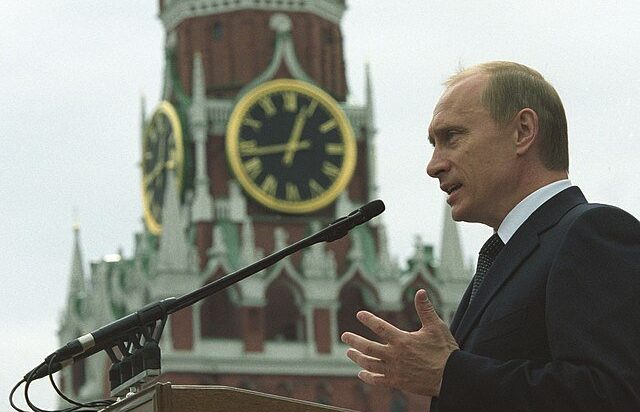Currently, nothing suggests that the Putin regime is at imminent risk of collapse. Nonetheless, it is crucial to analyze the potential political paths for Russia after Putin, as understanding these scenarios prepares us for the eventualities that may arise. We outline two primary strategic alternatives following Putin’s potential departure: a rapid shift toward democracy or a gradual evolution toward a more predictable and potentially more liberal autocracy. The path ultimately chosen will be shaped by Russian political forces and society, as well as influenced by the exiled opposition and the Western world’s approach to Russia.
Although many scholars and experts envision an immediate transition to democracy in post-Putin Russia, such an abrupt shift could backfire. Just as in the 1990s, the required rebalancing of power might result in political and economic turmoil, potentially fostering public demand for a return to another variant of “Putinism”—that is, unrestrained personalistic rule. Instead, a more realistic and feasible approach might be to back a type of authoritarian rule that is institutionally limited and relies primarily on a coalition that is inclined to avoid external aggressions, then exploit the weaknesses of that government to foster democratization “by mistake.” This oblique approach to democratization would require patience and involve uncertainty, but it has the potential to gradually loosen the new regime’s authoritarian control and shift the political balance in favor of democratic change.
Democratization: An Unlikely Outcome
Various scenarios of Russian democratization envision institutional reforms leading to a fundamental redistribution of political and economic power after Putin. Such institutional reforms would require weakening the authority of the presidency, transferring more powers to the parliament, and embracing “genuine federalism” with comprehensive decentralization. They would also necessitate increased public participation in national politics and local affairs.
Crucially, Russian elites and society at national, sub-national, and local levels might not be prepared to establish safeguards against a reversion from democratization to unrestrained personalistic rule. This risk becomes particularly acute if Putin’s departure happens in the course of the ongoing war in Ukraine. Under these circumstances, both elites and society would have insufficient time to move past nationalistic sentiments and security concerns and return to some semblance of “normality.” Additionally, the combination of domestic political instability, the unresolved war, and issues surrounding Ukraine’s occupied territories could strengthen the role of those security forces and elites who may be resistant to democratization.
Russia’s historical experiences in the 1990s serve as a cautionary tale. During this period, attempts to build center-regional relations on the principles of democratic federalism led to a considerable weakening of the federal center’s capacity, resulting in political and economic turmoil. Similar conditions could emerge following a post-Putin attempt at democratization and federalization.
The consequence of such instability could be, as it was in the 1990s, a societal longing for a “strong hand”—a political figure who pledges to restore stability and order. The return of a more centralized, authoritative governance style, with a government presided over by a strong and popular leader, would pose a significant risk to the consolidation of a democratic regime, potentially paving the way for the return of unrestricted personalistic autocratic rule under the guise of restoring order and stability.
Given its history, vast size, societal diversity, and high economic inequality, Russia presents a particularly challenging case for democratization, with low chances of success. Moreover, comparative studies indicate that the likelihood of any movement toward democratization is quite limited. Indeed, they find that following the failure of an authoritarian regime, a shift to another form of dictatorship is almost twice as likely as a transition to democracy. For instance, Hadenius and Teorell observed that from 1972 to 2003, “77 percent of transitions from authoritarian governments resulted in another authoritarian regime.”[1] Geddes et al. found similar trends for the period from 1946 to 2010.[2] Analyzing 32 regime changes in countries with over one million inhabitants that had been under autocratic rule prior to the regime change, Del Panta found that 21 transitioned to another autocracy and only 11 to democracy.[3]
More Predictable Authoritarian Rule: A Viable Path for Russia?
The alternative to immediate democratization is the promotion of a more predictable form of authoritarian rule, which can be conceptualized through the framework of Limited Access Orders (LAOs) proposed by North, Wallis, and Weingast in their 2009 work.[4] They categorize societies into two stable types of social orders, each characterized by distinct patterns of access to economic and political resources. Whereas Open Access Orders (OAOs) feature open political and economic competition, LAOs are characterized by rent-seeking elites who limit access to these resources. Most countries globally are categorized as LAOs. Transition from an LAO to an OAO, and the consolidation of the latter, is an infrequent and complex process. It presents substantial risks to the current elites, who therefore typically prefer to maintain LAO institutions.
Importantly, however, LAOs systematically vary in how they restrict or open access to political and economic resources.[5] Moreover, the balance of access to economic and political resources in an LAO is not static: it may either degenerate over time or move toward greater openness (at least in some spheres) without the elite committing to—or even contemplating—a transition to an OAO.
This suggests the potential for gradual liberalization of Russia’s LAO. As part of the liberalization process, the role of Western countries and the opposition would therefore be to incentivize the initiation of liberalizing reforms and the return to a more advanced stage of LAO. This approach implies tactical engagement with the non-democratic regime, with a view to gradually expanding the openness of the system without directly challenging the LAO framework.
The Strategy of Indirect Engagement
Insights from the conceptual framework and findings of Daniel Treisman’s “Democracy by Mistake: How the Errors of Autocrats Trigger Transitions to Freer Government” suggest that rather than demanding democratization directly, the opposition should focus on creating conditions that would make the new regime more likely to make “mistakes” that would then open the door to democratic reforms.[6]
Treisman found that in most cases since 1800, transitions to a freer government have not been the result of intentional reform by incumbents but have occurred because incumbents’ efforts to prevent democracy backfired and weakened their grip on power. Such miscalculations include poorly targeted concessions that emboldened the opposition, excessive repression that triggered backlash, and alienation of key elite supporters.
The insight here for Russia’s opposition is that when a post-Putin leader takes office, aggressively demanding maximal changes could be counterproductive, likely provoking a defensive consolidation of autocracy. A shrewder strategy might be to shape an environment in which the new leader becomes prone to miscalculations in an effort to preserve power. That is, rather than overtly confronting the regime, which might prompt an immediate and strong authoritarian response, the opposition could adopt a strategy of indirect engagement. This indirect engagement would not directly challenge the regime in a way that would necessitate suppression, confrontation, or isolation from the world. Instead, it would subtly influence the political landscape, creating a more complex environment for the regime to navigate.
The objective of such an approach would not be to directly provoke the regime into harsh responses, which might solidify its grip on power, but to subtly shift the political and social context in ways that would make it more challenging for the regime to exercise non-democratic control and would stimulate it to initiate liberalization. This strategy would require a deep understanding of the regime’s internal dynamics and vulnerabilities. It would involve identifying and exploiting gaps or inconsistencies in policy, governance, or public engagement. The opposition could leverage social and political networks to disseminate information, influence public opinion, or mobilize support in ways that would not be overtly antagonistic to the regime but would gradually erode the regime’s ability to manage a non-democratic narrative and engage in non-democratic control.
For example, the opposition could work to emphasize the costs of isolation from the world economy, forging ties with elites who might lobby against it. The opposition could also push for regional elections or referenda on popular non-ideological issues (like ecology).
In essence, the strategy is not about avoiding any challenge to the regime. Rather, it entails being selective about the nature and method of these challenges. It involves creating scenarios in which the regime’s usual methods of control and response might lead to errors in judgment or action. These errors, as Treisman’s analysis suggests, can then become catalysts for democratization, particularly if they weaken the regime’s legitimacy, exacerbate internal divisions, or cause critical situations to be mismanaged.
Conclusion
A decisive move toward democratization would represent a return to the political landscape of the 1990s, whereas significant political liberalization would “reset” the situation to circa 2010. The inherent challenge lies in the fundamental distinctions between these approaches, each of which has its own unique—and often conflicting—objectives, steps, and requirements for success.
This memo argues that an abrupt shift to democracy in Russia following Putin’s departure could backfire, resulting in uncertainty that might foster public demand for another variant of “Putinism.” While the ideal of democracy might be broadly appealing, many Russians might lack the patience, economic resources, and risk tolerance necessary to endure a prolonged and challenging transition period. That raises the following key question: Under what political and economic conditions would a transition to democracy in Russia be sustainable and not revert to personalistic rule?
Given the complexity of this question, we propose that a more realistic approach for the opposition might entail backing an institutionally limited form of authoritarian rule and then exploiting the weaknesses of that government to foster eventual democratization. This oblique approach would require patience and involve uncertainty. However, it could provide a roadmap for gradually loosening the new regime’s authoritarian control and shifting the political balance in favor of democratic change.
The international community will play a crucial role in shaping Russia’s path after Putin. While the temptation to push for rapid democratization may be strong, Western policymakers should recognize the potential risks and challenges associated with this approach. Instead, they should consider supporting the proposed strategy of gradual liberalization and democratization by engaging with the new Russian government, providing targeted assistance, and creating incentives for reforms. By adopting a nuanced, long-term approach that accounts for Russia’s unique political and economic context, the West can help foster an environment conducive to sustainable democratic change.
Irina Busygina is a visiting scholar at the Davis Center for Russian and Eurasian Studies, Harvard University.
Mikhail Filippov is a Professor of Political Science at Binghamton University, State University of New York (SUNY).
1] Axel Hadenius and Jan Teorell, “Pathways from Authoritarianism,” Journal of Democracy 18, 2007, 143–157, 152.
[2] Barbara Geddes, Joseph Wright, and Erica Frantz, “Autocratic Breakdown and Regime Transitions: A New Data Set,” Perspectives on Politics 12 (2), 2014, 313-331.
[3] Gianni Del Panta, “The Stubbornness of Authoritarianism: Autocracy-to-Autocracy Transitions in the World between 2000 and 2015,” Italian Political Science Review / Rivista Italiana Di Scienza Politica 49 (2), 2019, 139-155.
[4] Douglass C. North, John Joseph Wallis, and Barry R. Weingast, Violence and Social Orders: A Conceptual Framework for Interpreting Recorded Human History, Cambridge University Press, 2009.
[5] Esther Ademmer, Julia Langbein, and Tanja A. Börzel, “Varieties of Limited Access Orders: The Nexus between Politics and Economics in Hybrid Regimes,” Governance 33(1), 2020, 191-208.
[6] Daniel Treisman, “Democracy by Mistake: How the Errors of Autocrats Trigger Transitions to Freer Government,” American Political Science Review 114 (3), 2020, 792-810.











